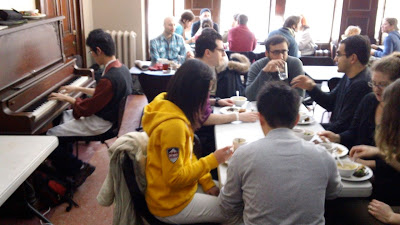
This blog exists to inspire change--to become more in harmony with nature, to appreciate our beautiful planet, and to help preserve it for future generations.
Thursday, September 22, 2011
Wednesday, June 22, 2011
Cycling in Prince Edward County














Last weekend I went for a joyride through one of Ontario's best cycling areas - Prince Edward County. I covered 86km starting from Prinyer's Cove in the northeast, passing through the towns of Waupoos, South Bay, Milford, and Picton. The roads were very quite--I encountered more cyclists than motorists--and there were many points of interest along what they call they Arts Trail and Taste Trail. Cycling is a great way to discover the lay of the land, and a peaceful and beautiful land it is!

Monday, June 6, 2011
Thanks busy bees for a job well done!

Honey is the ultimate in products derived from herbs. Fashioned through an ingenious alliance between animal and plant kingdoms, honey delivers a diverse array of phytochemicals in one package. This bounty arrives courtesy of the industrious honeybee, who visits some 2 million flowers to manufacture just one pound of honey." -Gina Mohammed
I also take a teaspoon of bee pollen every day. It's a superfood! There are 22 basic elements in the human body. Enzymes, Hormones, Vitamins, Amino Acids, and others - Which must be renewed by nutrient intake, no one food contains them all, except Bee Pollen!
Mmmm, mmmm. Honey golden as the sun.Thanks busy bees, for a job well done!
Tuesday, May 31, 2011
Greener Side Celebration and Mill Pond Splash




 With May bringing spring bird migration, blooming flowers, and pleasant temperatures, it's no wonder that nature festivals abound. I took my kids to Our Greener Side Celebration at the Kortright Centre for Conservation in Vaughan on May 28th, and the Mill Pond Splash on May 29th in Richmond Hill.
With May bringing spring bird migration, blooming flowers, and pleasant temperatures, it's no wonder that nature festivals abound. I took my kids to Our Greener Side Celebration at the Kortright Centre for Conservation in Vaughan on May 28th, and the Mill Pond Splash on May 29th in Richmond Hill.
Monday, May 30, 2011
A bike ride in pictures

Tuesday, April 5, 2011
Artificial Leaf turns Water into Energy for Cheap
The oxygen and hydrogen can either be passed through a fuel cell to generate electricity, or burned to generate heat. All the leaf needs is water and sunlight, and it will work for at least 45 hours without degrading in performance according to testing done in the lab.
http://www.

Thursday, March 17, 2011
Life, Money, and Illusion: Lesson from the East Coast Fishery



Monday, February 28, 2011
The truth about orange juice
 Alissa Hamilton is author of the book "Squeezed: What You Don't Know About Orange Juice
Alissa Hamilton is author of the book "Squeezed: What You Don't Know About Orange JuiceSunday, February 27, 2011
Thursday, February 24, 2011
GO Station's days are numbered




Saturday, February 19, 2011
Gangzhou, China wins sustainable transport award
Friday, February 11, 2011
Which has the higher density?

[from City of Hamilton Visioning Workshop]
Tuesday, February 8, 2011
What's Your Big Green Idea?
- Light rail in the median – should be more widespread (already beingplanned on Hwy 407); we should catch up; in between densely populated urban areas it would be a huge energy saver and also immune to congestion
- Driver education interms of awareness of cyclists and how to treat them on the roads
- Promotion of warm mix asphalt
- Smaller buses onthe road, especially on lesspopulated routes and off-peak hours; smaller buses are more than enough for these applications and are more efficient
- DVP bicycle tram (light rail) with major pick-up points (Salma Saad)
- Major bike arteries, with private and tax deductible funding (Salma Saad)
- Wider bicycle lanes on all major roads, like in Beijing, China
- Single fare system between cities/regions. It is too expensive to commute downtown when you need to buy multiple passes (Radhika Sagar)
- Piezoelectric type panels for electricity generation
- Eliminate HOV lanes; they are not a way of saving the environment and a wasted lane when cars sit and idle
- Increase cost of driving by charging road tolls; Implement a car tax a la Denmark
- Solar cells on top of cars to power them or contribute to some of its power. In parking lots it can be plugged in to a system and the owner can get a cut of the electricity made off the parked car. Rest goes to owner of land. (Armin Hamta)
- Wind generation along sides of busy highways; storing energy (heat) from busy highways that surrounding communities can tap in to.

Friday, February 4, 2011
Hot Yam


 I ate at Hot Yam yesterday. Run by student volunteers at the University of Toronto, it's a mostly local, mostly organic, and entirely vegan lunch for only $4. Not only is it healthy food to nourish you, it tastes amazing. It could just be the best deal in town. Available only on Thursdays from 12-2pm at the International Student Centre (33 St. George St.). Check out some recipes here.
I ate at Hot Yam yesterday. Run by student volunteers at the University of Toronto, it's a mostly local, mostly organic, and entirely vegan lunch for only $4. Not only is it healthy food to nourish you, it tastes amazing. It could just be the best deal in town. Available only on Thursdays from 12-2pm at the International Student Centre (33 St. George St.). Check out some recipes here.











